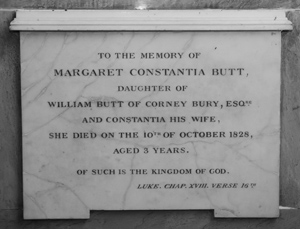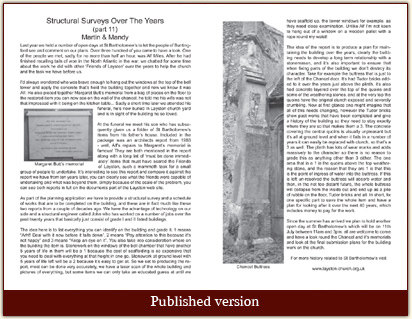Martin & Mandy

Last year we held a number of open days at St Bartholomew’s to let the people of Buntingford see and comment on our plans. Over three hundred of you came to have a look. One of the people we met, sadly for no more than half an hour, was Alf Miles. After he had finished recalling tails of woe in the North Atlantic in the war, we chatted for some time about the work he did with other ‘Friends of Layston’ over the years to help the church and the task we have before us. 
I’d always wondered who was brave enough to hang out the windows at the top of the bell tower and apply the concrete that’s held the building together and now we know it was Alf. He also pieced together Margaret Butt’s memorial from a bag of pieces on the floor to the restored item you can now see on the wall of the chancel, he told me his wife was not that impressed with it being on the kitchen table... Sadly a short time later we attended his funeral, he’s now buried in Layston church yard and is in sight of the building he so loved.
At the funeral we meet his son who has subsequently given us a folder of St Bartholomew’s items from his father’s house. Included in the package was an architects report from 1988 - well, Alf’s repairs to Margaret’s memorial is famous! They are both mentioned in the report along with a long list of ‘must be done immediately’ items that must have scared the Friends of Layston, such a mammoth task for a small group of people to undertake. It’s interesting to see this report and compare it against the report we have from ten years later, you can clearly see what the friends were capable of undertaking and what was beyond them, simply because of the scale of the problem, you can see both reports in full on the documents part of the Layston web site.
As part of the planning application we have to provide a structural survey and a schedule of works that are to be completed on the building, and these are in fact much like these two reports from a couple of decades ago. We have the advantage of technology on our side and a structural engineer called John who has worked on a number of jobs over the past twenty years that basically just consist of grade I and II listed buildings.
 The idea here is to list everything you can identify on the building and grade it. 1 means “Arh!! Deal with it now before it falls down”, 2 means “Pay attention to this because it’s not happy” and 3 means “Keep an eye on it”. You also take into consideration where on the building the item is. Stonework on the windows of the bell chamber that have another 5 years of life in them will be a 1 because the cost of scaffolding is so expensive that you need to deal with everything at that height in one go. Stonework at ground level with 5 years of life left will be a 2 because it’s easy to get at. So we set to producing the report, most can be done very accurately, we have a laser scan of the whole building and pictures of everything, but some items we can only take an educated guess at until we have scaffold up, the tower windows for example, as they need close examination. Unlike Alf I’m not keen to hang out of a window on a wooden pallet with a rope round my waist!
The idea here is to list everything you can identify on the building and grade it. 1 means “Arh!! Deal with it now before it falls down”, 2 means “Pay attention to this because it’s not happy” and 3 means “Keep an eye on it”. You also take into consideration where on the building the item is. Stonework on the windows of the bell chamber that have another 5 years of life in them will be a 1 because the cost of scaffolding is so expensive that you need to deal with everything at that height in one go. Stonework at ground level with 5 years of life left will be a 2 because it’s easy to get at. So we set to producing the report, most can be done very accurately, we have a laser scan of the whole building and pictures of everything, but some items we can only take an educated guess at until we have scaffold up, the tower windows for example, as they need close examination. Unlike Alf I’m not keen to hang out of a window on a wooden pallet with a rope round my waist!
The idea of the report is to produce a plan for maintaining the building over the years, clearly the building needs to develop a long term relationship with a stonemason, and it’s also important to ensure that when fixing parts of the building we don’t destroy its character. Take for example the buttress that is just to the left of the Chancel door. It’s had Tudor bricks added to it over the years just above the plinth, it’s also had concrete layered over the top of the quoins and some of the weathering stones, and at the very top the quoins have the original clunch exposed and severely crumbling. Now at first glance one might imagine that all of this needs changing, however the Tudor bricks show past works that have been completed and give a history of the building so they need to stay exactly where they are so that makes them a 3. The concrete covering the central quoins is visually unpleasant but it’s all at ground level and when it fails in a number of years it can easily be replaced with clunch, so that’s a 3 as well. The plinth has lots of wear marks and adds massively to the character so there is no reason to grade this as anything other than 3 either. The one area that is a 1 is the quoins above the top weathering stone, and the reason that they are 1 is that this is the point of ingress of water into the buttress. If this is left un-resolved the buttress will absorb water and then, in the not too distant future, the whole buttress will collapse from the inside out and end up as a pile of rubble on the floor, Tudor bricks and all. In short, fix one specific part to save the whole item and have a plan for looking after it over the next 40 years, which includes money to pay for the work.
that is a 1 is the quoins above the top weathering stone, and the reason that they are 1 is that this is the point of ingress of water into the buttress. If this is left un-resolved the buttress will absorb water and then, in the not too distant future, the whole buttress will collapse from the inside out and end up as a pile of rubble on the floor, Tudor bricks and all. In short, fix one specific part to save the whole item and have a plan for looking after it over the next 40 years, which includes money to pay for the work.
Since the summer has arrived we plan to hold another open day at St Bartholomew’s which will be on 11th July between 11am and 3pm, all are welcome to come and have a look round the Chancel and it’s memorials and look at the final submission plans for the building work on the church.
 |
|
 |
